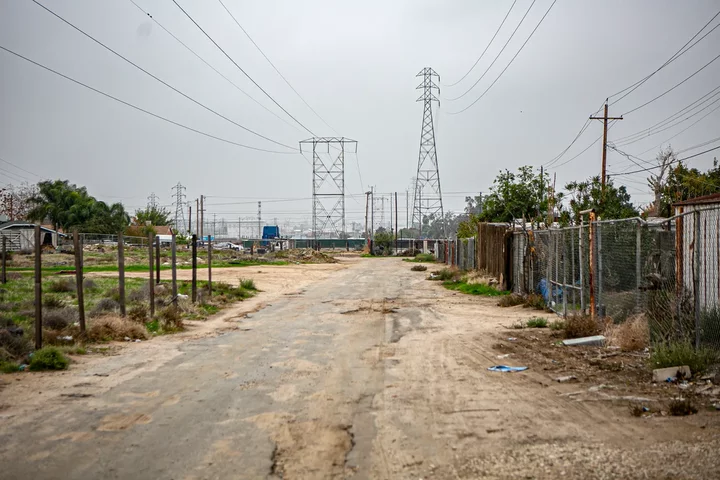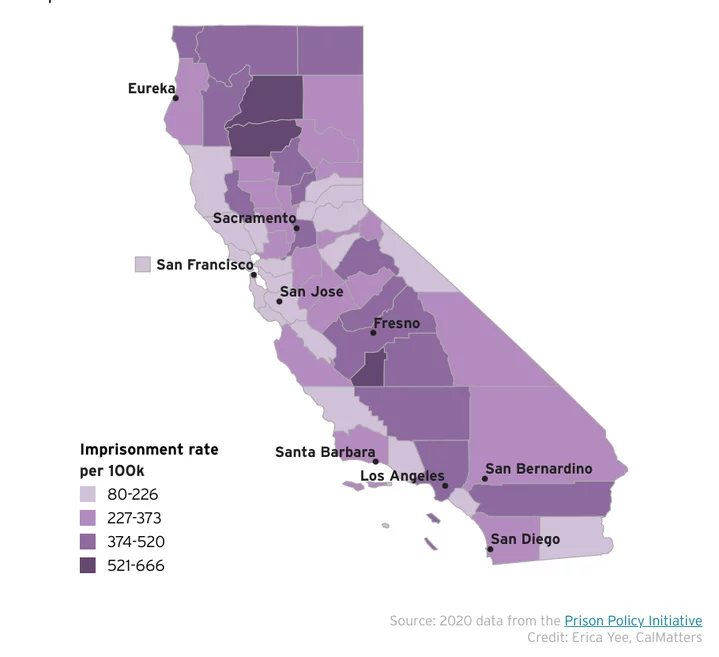Kern County (pictured here), along with the neighboring counties of Tulare and Kings, have among the state’s highest rates of incarceration of their residents. Now state prison inmates will be counted as residents of their home counties, not the places they are incarcerated. Photo by Larry Valenzuela for CalMatters
Shasta County in rural northern California has some of the state’s highest incarceration rates. Ask Robert Bowman what’s going on, and he takes a long, deep sigh.
“It’s a perfect storm of bad,” he said.
Bowman, director of the county’s program that helps formerly incarcerated people transition back to life outside, identifies three main drivers of crime in Shasta County: high housing costs, untreated mental illness and drug trafficking.
Those are some of the same factors blamed for crime in other California counties that rank among the highest for incarcerated people, according to a report released this morning by the Prison Policy Initiative, a nonprofit that seeks to end mass incarceration.
The report takes newly available data from California prisons to show where inmates come from – not just their home counties, but their neighborhoods. The group’s stated intent is to show lawmakers where they can better direct public dollars.
The neighborhoods where incarcerated people come from often have a higher percentage of Black and Latino residents than the state average, according to the report, while the counties that host the prisons are predominantly white.
The effect has been “the siphoning of political power from disproportionately Black and Latino communities to pad out the mostly rural and often predominantly white regions where prisons are located,” the study found.
Unsurprisingly, the most populous counties send the most people to state prison. Los Angeles County had the most people incarcerated, followed by Riverside and San Diego counties.
But in some counties, though they have fewer total people in state prisons, the rate of incarceration is much higher than the statewide average of 310 per 100,000 people.
Tiny Kings County in the San Joaquin Valley has the state’s highest incarceration rate at 666 per 100,000, the study found.
Shasta County ranked second among counties that send people to prison, with 663 county residents incarcerated per 100,000 people. The county of fewer than 200,000 is framed by mountains to its north, west and east. People move there for cheap land and open spaces, or burrow further into its hills to escape creeping modernity, Bowman said.
“And then we have those who have moved up here for political reasons and I’ll just leave it at that,” Bowman said with a laugh.
In one Shasta County Census tract that encompasses most of the city of Redding, more than one in every 100 people is in a state prison.
Disparities also persist in cities like Los Angeles, where the neighborhoods of Watts and Crenshaw have more than five times the incarceration rate of Bel-Air and Brentwood, according to the study’s calculations.
“There’s fewer Beverly Hills in our community,” Bowman said.
But many of the same issues that crop up in Los Angeles and San Francisco are true in far northern California: homelessness, untreated mental illness and a resistance among locals to new construction or low-income housing.
Bowman points to a proposed micro shelter at a Lutheran church in Redding that would serve as transitional housing for up to five people. Neighbors hung a sign on a chain link fence: “Tiny Houses = Big Problems.” The shelter is expected to open this fall.
“If you have billions of dollars to spend, but yet your community is overwhelmingly ‘not in my backyard,’ then you can get nothing done,” Bowman said.
The Prison Policy Initiative report is based on numbers provided by the state of California which, for the first time in its 2020 Census, counted prison inmates in their home districts instead of the cities and counties where they’re incarcerated.
The idea was to end what opponents called “prison gerrymandering,” which counted prison inmates as residents of their prison’s county. California ended that practice in 2011 with AB 420, signed by former Gov. Jerry Brown, but the law did not take effect until 2020. Ten other states have taken similar steps.
“It’s a perfect storm of bad.”
— Robert Bowman, Shasta County STEP-UP program
This year’s redistricting maps were the first to count incarcerated people in their home districts. The process to final approval by a state independent commission was fraught and messy, but has so far survived without a legal challenge.
“Our hope is really that policymakers and service providers will use this data to kind of direct some of their thinking on how they make choices about the people that they serve,” said Prison Policy Initiative spokesman Mike Wessler.
“For lawmakers, we hope that they’ll take a look at how many people in their own communities are lost to incarceration every single day.”
The Prison Policy Initiative study was taken from a snapshot of the 122,000 people in state prisons on April 1, 2020. It doesn’t count people in federal prison or immigration detention, nor does it count those who were identified in court proceedings as homeless.
Among cities with at least 20,000 people, Compton in Los Angeles County had the highest rate of incarceration, with 979 people incarcerated per 100,000 residents. It also has a higher Black and Latino population than the state average, which the report’s authors say mirrors a national trend.
“This suggests that policing, arrests and incarceration are disproportionately concentrated in a handful of Black communities across the county, such as Compton with its large Black population,” wrote the report’s authors, Emily Widra and Felicia Gomez.
One Census tract in Kern County stands out. Just east of downtown Bakersfield, the one-square-mile tract had 2,944 residents and 74 people in state prisons, or more than two out of every 100 people.
“Our hope is really that policymakers and service providers will use this data to (decide) … how they make choices about the people that they serve.”
— Mike Wessler, Prison Policy Initiative
Kern County also leads the state in homicide rate, a statistic the county’s residents and law enforcement struggle to explain. For the sixth consecutive year, the county led the state with a homicide rate of 13.7 homicides per 100,000 people. The statewide average is six homicides per 100,000.
“Some of the smaller rural counties often are overlooked but actually have some of the highest incarceration rates in the entire state,” Wessler said. “A lot of these rural areas are also facing significant economic challenges.”
You don’t have to remind Bowman of the Shasta County STEP-UP program for recently released inmates. First, in 2018, the Carr Fire displaced thousands of people in an area that was already struggling to control housing costs. Then, in the pandemic, wealthier residents of the Bay Area and Sacramento Valley started moving north, pushing up rents and home values. People already on the economic fringe were pushed to its edge.
“Because now, landlords could charge whatever they want and there’s no reason for them to open up their homes,” to affordable housing programs, Bowman said. “They can get someone who is displaced while their home’s being rebuilt (and) they can get a higher rent from that individual or family. So that’s a huge issue.”
He is, however, ultimately optimistic.
“I think that there are a lot of good people that are trying to do the very best they can,” Bowman said. “It just takes time for the numbers to come down.”
###
CalMatters.org is a nonprofit, nonpartisan media venture explaining California policies and politics.


CLICK TO MANAGE